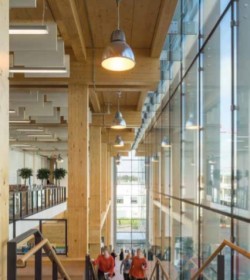Cross-laminated timber (CLT) has been the timber industry’s game changer since its conception and for good reason, yet the unpredictable events of the last couple of years show some refinement of the system is required. Rupert Scott, TRADA’s Membership and Marketing Manager, explains more.
Industry headlines seem to oscillate between the global climate crisis, the excitement of building large and building tall, and building safety in a post-Grenfell world – three areas in which CLT continues to have a role to play. It will undoubtedly, perhaps necessarily, be put through the wringer in the months to come but supporters of the material shouldn’t be alarmed.
Changes to Building Regulations postGrenfell now prevent CLT from being used in the external walls of high-rise residential buildings over 18 metres, which includes structural members within their scope. This means that CLT must be used within the building itself, e.g. post and beam construction, which is possible if more restrictive.
Most attempts to dissuade the use of CLT citing durability problems are overly sensational. It’s true that some issues with CLT can be traced back to high moisture levels, resulting from trapped construction moisture, poor design or leaks from the failure of other components, however, the effects of moisture can be managed, both during the construction phase and when buildings are in use. For example, CLT buildings can be erected quickly, but larger structures still take several weeks to build. In this scenario, it is important that contractors understand the importance of installing a weathertight shell as soon as practically possible, and the urgency of water management procedures which include deflection and drainage.
There are timber frame buildings which are hundreds of years old – we have every reason to believe that engineered timber buildings will enjoy the same durability, presuming good principles of construction and encapsulation are followed. Maintenance is also key to longevity.
Here at TRADA, our stance has remained clear: CLT is here to stay. The benefits of the material are just too advantageous to ignore. In a time of climate crisis turmoil, the existence of a renewable resource which sequesters CO2 is indispensable. No other material possesses the same power for carbon neutrality – something we should be seizing on as a nation following the Government’s commitment to net zero greenhouse gas emissions by 2050.
However, its excellent environmental credentials are not its only strength. Yes, all structural building materials have their investment advantages and disadvantages. At a first glance, CLT can cost more upfront than other materials – but like-for-like cost comparisons cannot do CLT justice because they are unable to take into account the very real cost savings that can be made as a direct result of programme savings, strength-toweight ratio and other environmental factors. To clarify, using engineered timber can shorten the build time by 10–20%, and involves significantly fewer deliveries, site storage requirements and construction waste than other materials – reducing both associated risk and costs.
There is a reason CLT is a favourite of time- or planning-sensitive projects such as schools and hospitals, where on-site time is limited and any disruption in the form of noise, dust or waste can be damaging. While using the material has no overt influence on securing viable planning consent, CLT has many benefits over other structural materials in their areas of concern, some of which have already been mentioned.
The material lends itself to many forms of offsite construction. In fact, timber offsite construction market share is improving year-on-year. In combination, they result in a building which assembles quickly, on a safer, cleaner site that produces less waste and dust and – most importantly – is more likely to be delivered on time. If a project is constrained by building height restrictions, CLT should be a contender as it has low floor-to-floor dimensions. If it’s innovative design you’re after, CLT’s capacity for wide spans or novel-shaped windows and doors might be a source of inspiration.
Finally, CLT is a possible answer to another crisis our nation is currently undergoing: mental health. Research is mounting supporting timber’s positive impact on our health and wellbeing, aligning it with biophilic design. CLT can be left exposed internally, resulting in a powerful finish – supporting worker physiology, sentiment and productivity. What more can you want? All these characteristics, in addition to sequestering carbon, make it a strong competitor. Here at TRADA, we are certain it is here to stay.
TRADA provides a wide range of independent, authoritative publications and technical guidance on timber for construction professionals. For more information on CLT and its benefits, you might be interested in the publications ‘Cross-laminated timber: design and performance’ or ‘Procuring engineered timber buildings: A client’s guide’ which are both available in the TRADA Bookshop.









